AUGMENTATIVE ALTERNATIVE COMMUNICATION SYSTEMS
Module Description:
The aim of this module is to aid the public, specifically Special Needs Educators, teachers and any individual that is collaborating with children with Autism Spectrum Disorders (ASDs), to understand the essence of a variety of therapeutic treatments, also referred to as Applied Behavioural Analysis (ABA), Treatment and Education of Autistic and Communication Handicapped Children (TEACCH) and Picture Exchange Communication Systems.
Specifically, through this module learners will gain extensive knowledge on the several variations of ABA, including Positive and Negative Reinforcement, Prompting and Fading, Task Analysis and Generalization. In addition, following Topic 1: , Applied Behavioural Analysis, the module proceeds to the methodologies that are being utilized, in order to implement TEACCH and Picture Exchange Communication Systems.

What is Applied Behavioural Analysis?


- Your co-workers get excited and think that you’re cool!
- For the ice cream party, your boss might tell everyone to leave a little early.
- You risk having a heated argument with your boss.
- Your bonus could be taken away if your manager is angry with you.
Therefore, your behaviour of bringing ice cream may vary in the future, depending on how it was received when you provided it. Depending on the outcome, you may bring it more or less frequently. In other words, the type of response that is generated after a behaviour (consequence), including a punishment or a reward, will determine whether that behaviour will be repeated again. However, when incorporating a punishment as a result, it will not always be perceived as an undesired or aversive outcome to an individual.
Therefore, it is vital to remember that each individual might be differently affected by a consequence and might not decrease their behaviour in the future (Fisher et al., 2021). In conclusion, this technique of documenting a response and then implementing the appropriate method for reinforcing or terminating a behaviour is also known as Applied Behavioural Analysis (ABA).

Figure 2. Video "What is ABA Therapy?". Source: LEARN Behavioural.
Link: https://www.youtube.com/watch?v=0OI187Ip4VQ
Click on this 2-minute video to learn more about the specifications of ABA!

Specifically, behaviour-analysis focused for Autism-Spectrum Disorders (ASD) uses reinforcement techniques in controlled and uncontrolled environments to enable the children to develop and learn new competences. Essentially, simple to advanced skills are deconstructed into manageable chunks and are taught methodically. Making it pleasurable for the student is a top focus. The learner is more likely to display acceptable behaviour both during and after the teaching engagement with carefully prepared guidance and reinforcement. Problematic behaviours, on the other hand, are not encouraged. To create a successful intervention strategy, some analysis may be required to identify the function(s) and reinforcers for these behaviours.
Nonetheless, prior proceeding to the sub-categorizing techniques that compose Applied Behavioural Analysis, it is essential to fully understand the various processes, of which this methodology is based upon. The objective of this methodology is to deduct conclusions from realistic scenarios and evaluate how a positive behaviour can be repeated and how a negative behaviour can be eliminated. Therefore, by applying this technique into the educational field the objective of ABA is to help educators and parents comprehend:
- How behaviours operate;
- How a behaviour can be impacted by the environment;
- How learning occurs.
However, in order for an ABA treatment to be successful, the practitioner should ensure that they integrate all 7 dimensions in the intervention plan of the child. The 7 dimensions include:
- Generality;
- Effective;
- Applied;
- Technological;
- Conceptually Systematic;
- Analytic;
- Behavioural;
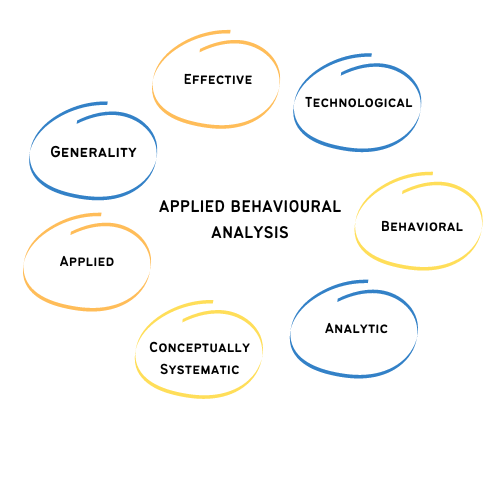

Generality:
When a behaviour is in need of change, this behaviour adjustment is not supposed to occur instantaneously, neither should it last only for a short period of time. The essence of this treatment is to ensure that the skills acquired within the intervention are not affected by the individual’s external factors, including their environment and the individuals surrounding them. ABA is frequently carried out in a controlled environment atmosphere or in a setting that is more clinical in nature.
However, despite the fact that the programming is originally carried out in this setting, the treatment plan should be created to reflect the patient's actual surroundings. Essentially, this technique will ensure that the behavior is generalized to various circumstances and situations and persists over time. While it is ideal to have a consistent staff during your child's treatment, the child should also have access to other children and professionals to practice their newly acquired abilities. A treatment is not deemed successful or effective until generality is attained.
.
Effective:
The interventions being employed must also be successful, by ensuring that the objectives reflect and are pertinent to the client and their community's culture. “Is the intervention working?” or "Am I seeing the desired progress?” are two crucial questions to ask. Frequent progress-monitoring of the collected data and observation of how the child is responding to the treatment, are the two variables answering these questions.

Applied:
The specific treatment objectives that require priority are formulated according to the significance level the patient and their family place. Each person's socially relevant actions are unique to them and are the skills that will help them fit in with their environment more successfully and effortlessly. In other words, for a treatment to be socially valid, it must cause and maintain adaptation during the child’s daily life.
For instance, if the child is engaging in a tantrum behaviour, because they have specific wants and needs, but has not acquire the skills to effectively communicate these necessities, the appropriate intervention tailored to this situation, is to teach the child how to effectively communicate their wants and needs. Thus, this objective would be a socially valid objective. It would not only exert an immediate-beneficiary impact on the child’s daily life, but I would also benefit the individuals that interact with the child, including family members, teachers, friends. The treatment team must always take the client's importance of the intended behavior change into account when choosing therapeutic strategies.

Technological:
The therapeutic intervention should be described so clearly, so that if there is a possibility that another individual would like to repeat the process, they will be able to replicate it, without any difficulties. All of the strategies that make up an intervention should be precisely identified and described in order to enable this. Consider your favourite cake-baking recipe from Pinterest as an illustration; it is clear, simple to follow, and beautifully written. Although using behavioural analytic therapies on individuals is undoubtedly more difficult, the same principles should apply.
Even if the technique described is unclear or difficult to understand, it is unlikely that everyone on the treatment team will approach treatment the same way. A technology behavioural intervention is simple to duplicate and has a high level of treatment integrity.

Conceptually systematic:
An intervention that is conceptually systematic is one that is grounded on research and adheres to applied behaviour analysis principles. Is this intervention congruent with the principles that have been found to be effective as identified in the research?

Analytic:
The analytical approach explains that the decisions being made are derived from the data, establishing that the interventions utilized are based on the gathered data. When analysing the data, we need to identify and alter certain factors if the intervention method is not cultivating the desired change in the intended behaviour.
We can establish a trustworthy link between our intervention and the development of the positive behaviour, once the intervention has been improved and the data reveals an improvement in the intended direction. This tackles the question of plausibility: will the intervention utilized and the data demonstrating the change, be adequate to indicate a trustworthy functional relationship?

Behavioural:
In order to modify behaviour, it must be observable and measurable. If we can observe behaviour, we can collect data to quantify it, and then we can alter it (Cooper et al., 2007). The word "behaviour" is not only used to refer to undesirable activity; it can also refer to suitable or desirable behaviour. Behaviour analysts aim to modify some behaviours while simultaneously enhancing others. In addition, it's critical to talk about "behaviour change" in terms of how it affects the child's life as a whole, not just their behaviour.

Evidently, ABA has been particularly effective in lowering extremely harmful behaviours including violence and self-harming behaviours. Applied behaviour analysis (ABA) is recognized as an evidence-based practice treatment strategy for people with autism spectrum disorder because it has demonstrated effectiveness in educating individuals with a variety of learning styles and developmental challenges (ASD). This indicates that there is a substantial body of research that has repeatedly demonstrated its efficacy. This also implies that the intervention can be beneficial for individuals, families, and professionals. A sleep routine, social skills, learning how to ride a bus, learning how to multiply numbers, and many other new abilities could be taught as examples of what could be learned.

Learning is deconstructed into smaller chunks to aid in step-by-step learning. Data collection is done to monitor the learner's progress toward the learning objective. Positive reinforcement is a crucial component of ABA because it encourages students to master skills, even those that are extremely challenging for them. Understanding what reinforces each person's conduct is crucial for behaviour modification because everyone has distinct reinforcers. In order to prevent dependence on reinforcement, reinforcement can then be decreased (or faded) over time and when a person develops new skills. (Bailey et al., 2017).
Figure 7. Video "Antecedent Behavior Consequence: ABC Charts & Model".Source: Teachings in Education.
Watch this 3-minute video to learn about the ABCs of ABA!
Essentially, Applied Behavioural Analysis is the overarching methodology that is utilized by educators and by parents themselves, to try and support children with ASD, by altering the behaviours that are ineffective for the children themselves.
However, ABA can be subcategorized into various simpler forms that will allow the teacher or the parent incorporate methodical techniques into the child’s daily life and ultimate lead to the desired change.

Techniques of Applied Behavioural Analysis:
Positive and Negative Reinforcement
What is Positive Reinforcement?

Reinforcement: A consequence or reinforcer, is provided after a desired behavior has been presented,
in the process of reinforcement, in order to improve the likelihood or maintain the behavior under similar circumstances.
One of the most popular ABA methodologies is the implementation of Positive and Negative Reinforcement. The fundamental ideas of ABA were developed through B. F. Skinner's study, who proposed and later proved that behaviour was affected by a process known as selection by consequences, which is comparable to Darwin's process of natural selection. In essence, Skinner identified that in a specific setting, actions that result in positive results will persist due to the process of reinforcement, whereas actions that result in negative outcomes will gradually disappear or decline. By offering reinforcers for successive approximations of the final target response—a procedure known as shaping—Skinner illustrated how responses could evolve or change over time (Gordan & Krishanan, 2015).

The primary behavioural management strategy utilized by ABA therapists is positive reinforcement, in which a child who complies with a request for behaviour change is rewarded. The objective is for the child to exhibit good behaviour in response to the reinforcement. Any item or activity that effectively strengthens and maintains the desired behaviour might be considered a reinforcer. Natural primary reinforcers include things like sleep and food. Children gradually develop secondary reinforcers that differ from child to child and include everything from praise to stickers and incentives.
There are many distinct reinforcer kinds, including favourite activities, tangible goods like toys, privileges, in between the least intrusive reinforcer type, which is praise, and the most intrusive reinforcer type, which is food (Baer, 2019).
What is the significance of Positive Reinforcement?
Overall, positive reinforcement and ABA therapy can have a profoundly positive impact on the lives of children with autism spectrum disorders and their families. With the use of this technique, children with autism kids can learn new skills that can be hard to teach and maintain. For instance, a few of these competences are:
- Verbal communication
- Non-verbal communication
- Social interactions
- Academic performance
- Functional life skills
- Adaptive learning skills.
Children are more likely to repeat a desirable behaviour when it is followed by a reinforcer, like a special item or activity. Positive reinforcement can promote behavioural changes over time. The method can also assist these children in learning alternatives to repetitious activities and stop undesired behaviours like hostility. Specifically, one of the main benefits of positive reinforcement is that it is a consistent and reliable teaching strategy. Furthermore, it might be challenging for children with autism to switch to a new activity, because they frequently become fixated on a single task. If they manage to complete a task correctly, positive reinforcement enables them to know what to anticipate. In other words, it supports the notion that switching activities can be a positive experience, rather than a frustrating one (Leach & Duffy, 2009).
So how can ABA therapists or SEN educators utilize positive reinforcement?

One of the key ideas in applied behaviour analysis, the ABC model of behaviour modification, serves as the foundation for the technique. The following steps make up the model:
- A: An event or thing that causes the desired action is called an antecedent.
- B: Behaviour is the effect of the antecedent and is the action taken. It may be both favourable and unfavourable.
- C: The result of those activities is the consequence.
Depending on whether the activity is favourable or harmful, it can be utilized to either encourage or to inhibit it. Subsequently, once the targeted behaviour has been identified, the professional will initially assess the child's current ability levels and pinpoint the key areas that need the most improvement (Kazdin, 2022). The therapist will next create a customized program to teach new competences, skills and behaviours, that are suited to the child's requirements, skills, and interests. The ABA therapy plan is always created to satisfy the needs of each unique child, family, and circumstance. The expert will methodically employ positive reinforcement approaches to assist the child in learning and developing new abilities. This technique is an important tool for raising the possibility that new, beneficial habits will be continued and preserved over the long run (Taylo, 2022).

However, another vital component for the success of this ABA technique, is the educator’s ability recognise and implement the appropriate reinforcers for each child.
The professional must select the proper reinforcers, once determining what is most important or motivating to the child and to what the child has previously, reacted positively. This could be a particular toy, a preferred game, or a pastime. It is vital to withhold a variety of reinforcers, as every child will accept a different reinforcement strategy from their educator.
Even so, prior the implementation of various intrusive reinforcers, such as food, ABA professionals frequently initiate the treatment with the least intrusive methods. Additionally, they frequently combine a primary reinforcer with an additional item, to form a secondary reinforcer, such as saying "excellent job". For instance, praising the child with phrases such as “that was really good”, whilst simultaneously providing them with a treat, like a raisin or a candy, will assist in the maintenance of the desired behaviour. Essentially, the technique of reinforcement is completed by combining the positive responses to the reinforcer, until the child starts associating the action with the reward (Degli et al., 2020).


Nonetheless, although positive reinforcement has been documented as one of the most successful techniques of ABA and specifically for children with autism, it is not the only reinforcement method that can be utilized to alter a child’s behaviour. Reinforcement is subcategorized into two pillars:
- Positive reinforcement.
- Negative reinforcement.
The aetiology of why these two words are utilized; “positive” and “negative”, is because when exercising positive (+) reinforcement, the professional adds items or rewards to encourage or inhibit a behaviour. Contrastingly, the notion of negative (-) reinforcement includes the removal or subtraction of a stimulus, once the desired behaviour has been achieved.
What is Negative Reinforcement?
As explained above, when a certain stimulus—typically an aversive stimulus—is removed after a particular action is displayed, negative reinforcement takes place. Due to the removal or avoidance of the negative consequence, the possibility that the specific conduct will take place again in the future increases. However, negative reinforcement should not be viewed as a kind of punishment (Cooper et al., 2007). In contrast to punishment, which decreases a behaviour, negative reinforcement increases the behaviour.
Here are a few examples that demonstrate negative reinforcement:
- To avoid his mother's nagging, Bob does the dishes (behaviour) (aversive stimulus).
- After eating two bites of her broccoli, Natalie is able to leave the dinner table (aversive stimuli) (behaviour).
- Martha wears her earplugs (behaviour) to remove any noises (aversive stimulus)
- Steve is taking a shower (behaviour) to remove a bad smell (aversive stimulus).
- Joe acts in a way that deactivates a loud alarm by pressing a button (aversive stimulus).
It is crucial to always remember that the ultimate objective of reinforcement, is to try and improve an individual’s behavior, whereas the objective of punishment is to diminish a behavior. Consider adding something positive to a situation to enhance a response as positive reinforcement. Removing an undesirable stimulus to improve a response, on the other hand, is negative reinforcement.
Watch this 2-minute video for an additional clarification on negative reinforcement and punishment!
Furthermore, a common misunderstanding about negative reinforcement is that an individual is engaging in a “negative” or “bad” behaviour and benefits from it, which is of course not true. This argument would be best refuted by another example.

A parent and his child are going to the supermarket to buy some food together. The toddler snatches a large bag of candies and throws them into the cart as they pass by the candy aisle. The parent removes them and instructs the child to replace them. The kid screams and falls to the ground because he wants the candy. In order to manage the child's temper, the parent caves in and lets him have the candy.
It would appear that the tantrum (his behaviour) was adversely reinforced with treats because this boy's behaviour could be characterized as "negative." However, the fact that he received the candy really served as a reinforcer to his “good behaviour”!
When the child realized he would not get his sweets, he began to act out (have a tantrum), which evidently, lead to the opposite outcome and managed to earn the candies. As mentioned before, negative reinforcement, is when a (aversive) stimulus that is already present, is eliminated as a result of a desired behaviour and its removal was a desired outcome (e.g., Steve’s bad smell).

In this instance, the behaviour of the parent was the attitude that was negatively reinforced. The child's outburst and the attention they were receiving by the other individuals in the store, was an undesired situation for the parent (developed an aversive situation for the parent). This unpleasant circumstance occurred prior providing the child with the candy. Subsequently, once the parent offered the candy to the child, the child’s yelling was cessated and the aversive situation was eliminated.
As a result, the parent's behaviour was negatively reinforced (Wiering & Otterlo, 2012).
Therefore, aversion-inducing stimuli, such as bad odours, loud outbursts, or snoring, typically make people want to flee, or escape. The word "escape" is typically linked with an individual leaving, in order to eliminate the contact with the aversive stimulus, such as escaping from a prison. However, this phrase can also be utilized to refer to the elimination of the adverse stimuli itself, whilst the individual remains in the situation.
In other words, when taking into account the example of the “bad smell”, the individual is not “escaping”, he is to deal with the aversive stimulus (bad smell) until they take a shower, however taking a shower is still an effort to avoid the unpleasant stimulus.
Escape and Avoidance:It's crucial to understand that there is a difference between avoidance behaviour and escape behaviour (Miltenberger, 2008). While avoidance stops the adverse stimulus from happening in the first place, escape involves removing an existing aversive stimulus by behaviour. Keep in mind, too, that negative reinforcement still keeps both avoidance and escapist behaviour in place (Iwata & Smith, 2007).
For instance, the individual decides to take a shower as an "escape" from the unpleasant odour. When a behaviour stops the aversive stimulus from ever "happening” avoidance occurs. Hence, if the person is aware that they begin to smell as a result of not taking a shower, their showering behaviour is likely to increase in order to stop the smell from happening, and this would be considered "avoidance". The difference is whether the behaviour eliminates an adverse stimulus that is already present (escape) or delays the emergence of an aversive stimulus (avoidance) (Dymond & Roche, 2009).

Evidently, reinforcement is compromised from a variety of sections and there are several versions of this technique that can promote, not only beneficiary actions, but persistent alterations in behaviour, without the implementation of forceful or aggressive means (Fein & Dunn, 2007). Similar to reinforcement, another innocent, but equally effective methodology is prompting and fading.
Prompting and Fading
The term "prompting" in applied behavior analysis (ABA) or any other type of behavioral therapy refers to giving support or cues to encourage the application of a certain skill. The ultimate goal is for the individual to eventually perform the skill independently in the proper conditions without the need to be prompted, but prompting encourages the individual to perform a task until they learn how and when to do it.
In other words, prompting may encourage the child to perform a task, until they learn how and when to complete it, but ultimately, the main goal of this technique, is for them to learn how to perform the skill independently, in the appropriate circumstances, without needing to be prompted. However, what is a prompt?
A prompt is defined as any stimulus that the ABA practitioner or SEN educator recognizes as useful and that the child responds to. Prompts are usually delivered as antecedents, or prior the initiation of the behavior. If the child is already performing the skill or activity, a prompt is not necessary; rather, it may be appropriate to use positive reinforcement to support the behavior, in order for the child to maintain this behaviour (Fentress & Lerman, 2012).
Nonetheless, this method is used as a means of offering instructions to children with special educational needs and learning difficulties, as it can facilitate their understanding of what they have to do and thus increase the likelihood that they will later produce the correct response or desired behaviour on their own (Team, 2021).

- Fully Physical Prompt: commonly known as the hand-over-hand prompt, it includes physically guiding the hand of the child to complete the task and produce the correct response.
- Partially Physical Prompt: providing some physical assistance to the child, to finish only a part of the task and not all of it.
- Modelling Prompt: illustrating the entire behaviour or activity to the child and then ask them to replicate it.
- Gestural Prompt: utilizing a variety of hand movements (e.g., pointing, reaching, nodding) to offer guidance or information to the child about the correct response.
- Visual Prompt: presenting a visual cue or assistance to the child (e.g., pictures, drawings, photographs) to aid them comprehend what they must complete.
- Verbal Prompt: sharing a verbal cue or assistance to the child (e.g., first syllable of the answer) to help them understand what they have to do.
- Positional Prompt: providing the proper response's information in close proximity to the student, so that it can be more easily accessible (Maedan et al., 2013).
These prompts are provided according to their level of intrusiveness, initiating the procedure with the least intrusive and then proceeding to the most intrusive prompt (Chicago ABA Therapy, 2017). The quantity and kind of cues utilized are influenced by the surroundings, the resources at hand, as well as the unique demands and behaviours of each child. This means that the method and kind of prompting must be tailored to the skill or behaviour being taught as well as the child, as some types of prompting may be more or less effective depending on the student. There are two methods of prompting: "Most-to-Least" prompting and "Least-to-Most" prompting (Griffin, 2020).

In the beginning, the "Least-to-Most" prompting strategy entails giving the child the least invasive forms of prompts, in order to give them the chance to independently think of how they might complete the task. The level of intrusive prompting will then steadily increase, until the intended response is achieved, in case the child provides an inaccurate response or does not reply at all. For instance, if an ABA practitioner verbally prompts a kid, "Please give me the pen" and the child doesn't react, the practitioner can use a more intrusive method of prompting, such as positioning the pen closer to the child, to increase the likelihood that the child will respond.
Furthermore, when enforcing ABA, prompting and fading are the two techniques that are frequently used. Initially, prompting includes the provision of prompting cues to encourage a specific behaviour or response, whilst contrastingly, fading is the process of gradually eliminating the prompt cues, as the student becomes familiar to exhibiting the desired behaviour or the appropriate response (Chandrasekaran, 2020).
The objective of fading, is to ensure that the child does not become dependent on the provision of cues, in order to perform a behaviour or exhibit a response and verify that the child will exhibit that behaviour, once these cues has been eliminated. The "Most-to-Least" method of prompting is a type of fading because it gradually reduces the level of interruption caused by the prompts and methodically reduces the amount of help provided to the kid to achieve the desired job (Leaf et al., 2016). When implementing the "Most-to-Least" method, the following steps can be used, when teaching a child how to put on their jacket:
- The practitioner physically prompts the child to put on the jacket;
- The practitioner models (shows themselves) how to put on the jacket for the child;
- The practitioner verbally prompts the child to put on the jacket;
- The child puts on the jacket by themselves without any assistance or prompting.
When both prompting and fading are correctly employed and coupled, the child will learn how to exhibit and perform specific behaviors and complete certain tasks on their own. The learning process that occurs during ABA is depicted in the chart below, along with the stages at which prompting should occur:

Task analysis
Definition

Task analysis is used to break complex tasks into a sequence of smaller steps or actions. For some individuals on the autism spectrum, even simple tasks can present complex challenges. Understanding all the steps involved for a particular task can assist in identifying any steps that may need additional instruction and will help teach the task in a logical progression. A task analysis is developed using one of four methods. First, competent individuals with proven experience can be observed and steps documented. A second method is to consult experts or professional organizations with this expertise in validating the steps of a required task. The third method involves those who are teaching the skill to perform the task themselves and document steps. This may lead to a greater understanding of all steps involved. The final approach is simply trial and error in which an initial task analysis is generated and then refined through field tests (Dr. Cathy Pratt, 2020).

When writing a task analysis, we try to break the skill down into very specific steps, to create manageable steps. A task analysis often goes hand in hand with chaining.
Chaining = a set of teaching procedures used to teach a task analysis.
Task analysis is implemented in one of three ways, depending on the needs of the learner:
- Forward chaining—moving throughout the sequence with the first step first
- Backward chaining—moving throughout the sequence with the last step first
- Total task teaching—moving throughout the sequence, with only those problematic steps broken down into simpler steps
Watch this 13-minute video to learn more about task analysis.
Forward chaining is an alternative method for teaching complex behaviors that can be broken down into a series of steps. In forward chaining, the first step of a task analysis is taught first followed by each succeeding step, requiring the cumulative performance of all the previous steps in the correct order until the learner performs the whole chain of tasks independently (Cooper, 2007).
In this way, individuals learn complex behaviors in their correct sequence (McDonnell, 1988).
ABA practitioners using task analysis must first (1) identify the skill to be learned and (2) ensure that the learner masters all the discrete skills required to successfully complete the task. For example, if the child does not yet have the dexterity to hold a toothbrush properly, task analysis for teaching teeth brushing cannot yet begin.

Learning the benefits of Task Analysis will provide an insight to educators,
as to how this strategy will help them teach learners with ASD a skill that is too challenging to teach all at once.
Examples

A task analysis is used to break complex tasks into a sequence of smaller steps or actions. For some individuals on the autism spectrum, even simple tasks can present complex challenges.
Skills taught using task analysis (TA) include daily living skills such as brushing teeth, bathing, dressing, making a meal, and performing a variety of household chores. Task analysis can also be used in teaching students to perform tasks at school such as eating in the cafeteria, morning routines, completing and turning in assignments, and other tasks. Task analysis is also useful in desensitization programs such as tolerating haircuts, having teeth cleaned, and tolerating buzzers or loud environments. (Dr. Cathy Pratt, 2020).
Task Analysis for Brushing Teeth (Kregal, 2008), Functional Curriculum, Second Edition
- 1. Get your toothbrush case.
- 2. Unzip the case.
- 3. Take out toothpaste.
- 4. Unscrew toothpaste cap.
- 5. Lay cap on countertop.
- 6. Turn on cold water.
- 7. Take out your toothbrush.
- 8. Wet bristles of toothbrush.
- 9. Put toothpaste on toothbrush.
- 10.Lay toothpaste tube on countertop.
- 11.Bring toothbrush with paste up to mouth.
- 12.Begin brushing teeth.
- Left back: top – outside then inside
- Left back: bottom – outside then inside
- Then front: top – outside then inside
- Then front: bottom – outside then inside
- Then right back: top – outside then inside
- Then right back: bottom – outside then inside
- 13.Spit toothpaste into sink
- 14.Rinse toothbrush under water stream.
- 15.Shake water out of brush.
- 16.Put toothbrush in toothbrush case.
- 17.Get drinking cup from case.
- 18.Fill cup with cold water.
- 19.Rinse mouth with water.
- 20.Spit water into sink.
- 21.Rinse cup with water.
- 22.Wipe cup dry.
- 23.Put toothpaste cap on tube.
- 25.Put toothpaste into toothbrush case.
- 24.Put cup back into toothbrush case.
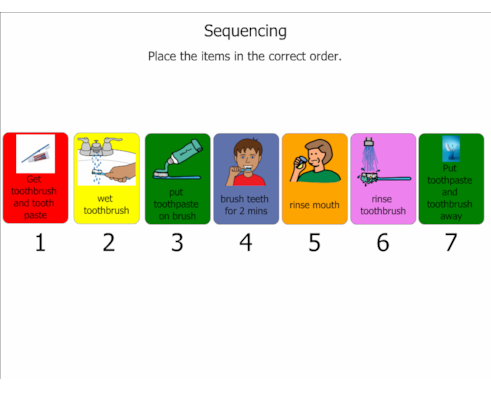
Watch this video to see a visual example
example of using task analysis for tooth brushing
Putting a Coat On
- Pick up the coat by the collar (the inside of the coat should be facing you)
- Place your right arm in the right sleeve hole
- Push your arm through until you can see your hand at the other end
- Reach behind with your left hand
- Place your arm in the left sleeve hole
- Move your arm through until you see your hand at the other end
- Pull the coat together in the front
- Zip the coat
Washing Hands
- Turn on right faucet
- Turn on left faucet
- Place hands under water
- Dispense soap
- Rub palms to count of 5
- Rub back of left hand to count of 5
- Rub back of right hand to count of 5
- Turn off water
- Take paper towel
- Dry hands to count of 5
- Throw paper towel away
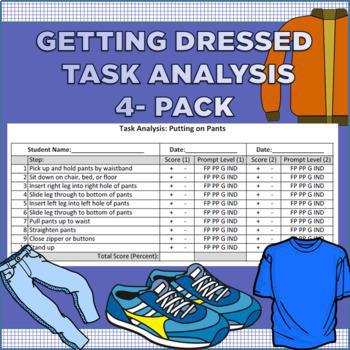
Source: Teachers pay Teachers
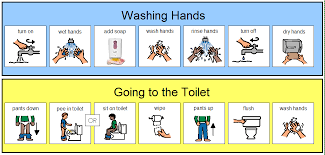
Source: Center for treatment and development
Additional resources

For additional information, Teachers and Professionals can address the following websites, linked with the largest and most reputable organizations worldwide. This article may also be very useful and informative in terms of task analysis training (Diane M. Browder, 2007).
Association for Behavior Analysis International (ABAI)
Since 1974, ABAI has been the largest membership organization for those involved in any aspects of behaviour analysis. They provide many services to its members including events, scholarly journals, special interest groups and access to affiliated chapters.
Association of Professional Behavior Analysts (APBA)
APBA is a 501 non-profit membership organization whose goal is to advocate and advance the science and teachings of applied behaviour analysis. Members have access to many resources such as news articles, professional credentialing, steps to avoiding antitrust liabilities, health insurance navigation and other special articles.
Behavior Analyst Certification Board (BACB)
BACB is a non-profit corporation established in 1998 to provide professional credentialing needs for behaviour analysts, their patients and the government. Their mission is to protect consumers of behaviour analysis services. They provide information about all the possible behaviour analysis certifications.
Tips

By learning how to use Task Analysis Teachers will have a better understanding of all the steps involved for a particular task, while identifying any other steps that may need extra instruction and will help teach the task in a logical progression.

Source: FreepicLink:
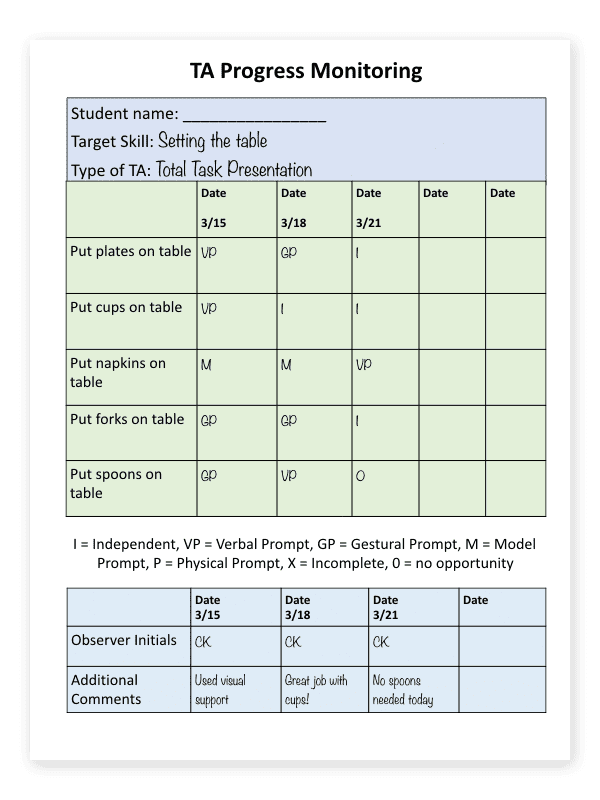
Source: n2u
Generalization
Definition

The term generalization, defined most broadly, is used to describe when skills learned in a training environment transfer to the natural environment after training has ended. Generalization, in its narrower definition, is a behavioral term that is used to describe the spread of effect of a training procedure to untrained stimuli and responses, as well as the durability of treatment effects over time. Generalization includes three specific forms: Stimulus generalization, response generalization and maintenance. Stimulus generalization involves the occurrence of a behavior in response to another similar stimulus.

Source: n2u

For example, a child who learns to say “ball” (behavior) in response to a picture of a ball (trained stimulus) shows stimulus generalization if he says “ball” in response to an actual ball (new stimulus). Response generalization involves the spread of an effect of a trained response to other similar responses (Wainer, 2013).
The past 20 years has seen a marked increase in the quantity of research literature investigating the effectiveness of interventions for people with autism spectrum disorders (ASD). Much of this research has been conducted in applied behavior analysis (ABA), however, many reported interventions do not include information or data on generalization and maintenance of behavior change. The importance of this is self-evident, as an intervention that increases or decreases a behavior is of little use if the behavior change is not observed in a variety of settings and fails to continue after the intervention period has ended (Angela M. Arnold-Saritepe, 2009).
Watch this video to learn more about Generalization.
Types of Generalization (Cooper, Heron, & Heward, 2007):
- Response Maintenance
Child continues to exhibit target response in absence of intervention - Setting/Situation (Stimulus) Generalization
Child exhibits target response under untrained stimulus conditions - Response Generalization
Child exhibits untrained responses that are functionally equivalent to target response
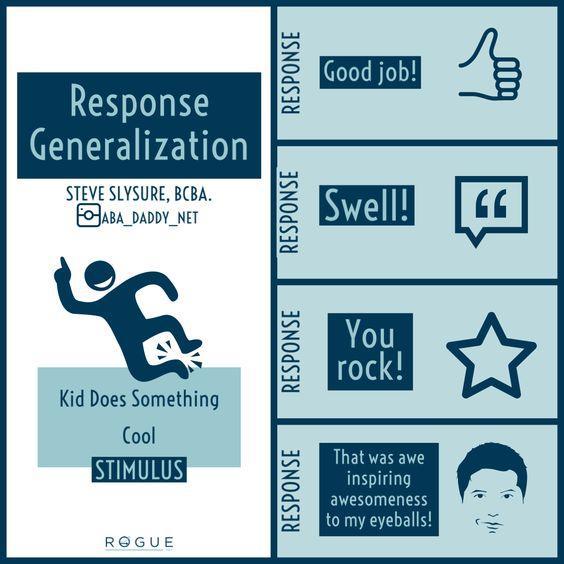
Source: rogueaba

Procedures to Promote Generalization and Maintenance:
- Sequential Modification
- Teach behavior and assess for generalization
- Teach across successive conditions if generalization does not take place
- Assess for generalization in each successive condition
- Introduce to natural maintaining contingencies
- Teach behaviors that will contact reinforcement outside of the training setting
- Program contingencies to be like typical contingencies
- Restructure outside environment to allow for reinforcement
- Train sufficient exemplars
- Teach multiple targets for same skill and assess for generalization to new targets until generalization occurs (e.g., continue teaching imitation responses until child imitates untaught responses)
- Teach child to respond correctly in presence of multiple stimuli and assess whether skill generalizes to new stimuli
- Teach targets that represent a wide range of possible response requirements and/or stimulus conditions that may occur under typical contingencies (Cooper et al., 2007)
- Use various stimuli when teaching a particular target and teach various targets
- Use in discriminable contingencies
- Set up reinforcement contingencies so child is unable to discriminate when reinforcement is available for a particular skill
- Begin providing delayed reinforcement once a skill has been mastered (Cooper et al., 2007)
- Use intermittent schedules of reinforcement to decrease discriminability of contingencies and enhance resistance to extinction
- Provide noncontingent reinforcement intermittently in generalization setting to maintain responding
- Program common stimuli
- Include stimuli during training that will be present under typical contingencies
- Choose stimuli that are salient and relevant to target behavior
- Use peers and/or common tasks as common stimuli for some target behaviors
- Mediate generalization
- Teach child to engage in behaviors that can be used to promote responding across multiple conditions
- Use language as a mediator for generalization
- Teach child rules that may promote generalization
- For example, “I wash my hands before I eat.”
- Use picture schedules as a mediator for generalization (Wacker, Berg, Berrie, & Swatta, 1985)
- Train to generalize
- Consider generalization as operant response rather than as product of behavior
- Reinforce response variability
- Novel correct responses → Sr+
- Correct responding under typical contingencies → Sr+ (Miltenberger, 2004)
- Instruct child to generalize
- Tell child to engage in target behavior in generalization setting, or tell child to engage in varied responding (Cooper, 2007).

TECHNIQUES FOR TEACHING GENERALIZATION
When a new skill is introduced to a student, plans for generalizing that skill can begin to be developed. There are several methods to teach the generalization of skills. The method utilized is dependent on the individual needs of each student., as well as the resources available.
Some key methods include:
1. If a teaching program was successful in one setting, implement the same teaching program in a different setting.

For example, if a student demonstrates being able to count to ten in one environment, the strategies and supports provided in this setting would be duplicated in other settings. This may also include environmental arrangement, materials, and staff.
2. Teach students functional skills, such as asking to get a drink, where the student getting a drink would be a natural reinforcer. If all staff involved with a student learning this skill, respond consistently to this request, the natural reinforcer (getting a drink) will be strengthened, and the student will be more likely to continue demonstrating this skill across people and environments.
3. Once a skill has been demonstrated in response to a specific instruction, begin to change that instruction slightly.

For example, if a student learns to identify an item when told, “show me ___”, begin changing the instruction. This may include statements such as, “point to the ___”, “where is the ___?”, etc. In addition, varying materials and staff can be introduced. (*Note: Change only one variable at a time.)
4. Once a skill has been demonstrated consistently, start to thin out how often one begins to reduce the frequency with which the student receives social or tangible reinforcement. By thinning reinforcement to a variable, or unpredictable schedule, the student will be more likely to continue performing the skill, promoting skill maintenance.
5. Have students monitor their own behaviour and skills under varying conditions (environment, people, and materials) by documenting their performance.
6. Provide social praise and reinforcement for generalized skills. When reinforcing a skill that is being generalized, staff can reinforce both prompted and independent responses (Board).